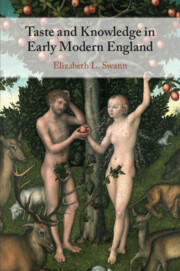Book contents
- Taste and Knowledge in Early Modern England
- Taste and Knowledge in Early Modern England
- Copyright page
- Dedication
- Contents
- Figures
- Acknowledgements
- Note on the Text
- Introduction
- Chapter 1 ‘To dream to eat Books’
- Chapter 2 Anatomizing Taste
- Chapter 3 From Eve’s Apple to the Bread of Life
- Chapter 4 ‘Those Fruits of Natural knowledge’
- Chapter 5 ‘Honey secrets’
- Afterword
- Bibliography
- Index
Chapter 3 - From Eve’s Apple to the Bread of Life
Piety and Palate in Devotional Literature
Published online by Cambridge University Press: 08 October 2020
- Taste and Knowledge in Early Modern England
- Taste and Knowledge in Early Modern England
- Copyright page
- Dedication
- Contents
- Figures
- Acknowledgements
- Note on the Text
- Introduction
- Chapter 1 ‘To dream to eat Books’
- Chapter 2 Anatomizing Taste
- Chapter 3 From Eve’s Apple to the Bread of Life
- Chapter 4 ‘Those Fruits of Natural knowledge’
- Chapter 5 ‘Honey secrets’
- Afterword
- Bibliography
- Index
Summary
This chapter explores how taste’s epistemological utility in the early modern period was compromised by its disreputable moral status: taste was often identified as the cause of Adam and Eve’s fall. Nonetheless, sacramental tasting held out the promise of redemption. Eucharistic practices, I propose, provide a crucial context for the Protestant poetics of authors including George Herbert, Andrew Marvell, and Amelia Lanyer. Frequently, for instance, the language of taste is used – with varying levels of commitment – to affirm the superiority of experiential faith over clerical and scriptural authority. Simultaneously, religious writing, from poetry to polemic, offers a neglected source to uncover popular understandings and experiences of everyday, physical tasting. In particular, even banal, quotidian experiences of eating were conceived of as opportunities for spiritual illumination, precisely – and paradoxically – because of the fallenness of taste.
- Type
- Chapter
- Information
- Taste and Knowledge in Early Modern England , pp. 101 - 143Publisher: Cambridge University PressPrint publication year: 2020

